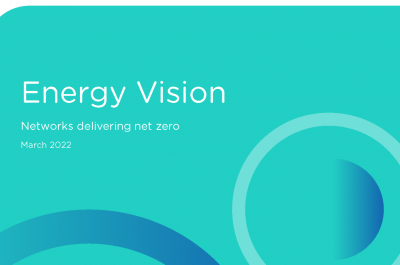Culture clash – why the energy revolution needs a new regulatory mindset
A global fact-finding mission has confirmed the need to take risks and reward innovation to support the energy network transformation, writes Geoff Petersen[1].
“Culture eats regulation for breakfast” (with apologies to Peter Drucker).
On our recent trip to the US and UK, we were struck by how often regulatory culture was raised as a potential barrier to energy sector transformation. Among the many people we spoke to – including academics, regulators, policy-makers, ‘new energy’ businesses and networks – there was a strong sense that the culture and mindset of all key stakeholders was going to be critical in effectively navigating the sector transformation.
Our regulatory culture is inevitably shaped by history. Our views on industry structure, the role of networks and what is desirable in terms of consumer outcomes, will be heavily influenced by past experience. Where a particular industry structure or regulatory paradigm has failed in the past, we are reluctant to contemplate going back there. On the other hand, where regulatory tools have been successful in other industries, we are quick to seize on this precedent.
We are certainly not alone in looking to history to guide our decisions on future regulatory design.
During our visit to California, it became apparent that the views of all stakeholders on industry structure and regulatory design have been fundamentally shaped by the events of nearly two decades ago, when Enron collapsed, with major financial consequences for the state. As a result, when you mention the idea of contestability in California today, the usual response is: “oh we’ve tried that, it didn’t work, and we don’t intend to try it again”. The scars of history run deep.
While we certainly shouldn’t ignore history, our regulatory culture and mindset needs to be capable of adapting to changes in the industry landscape.
Here are three areas where we sense that our existing regulatory culture could hold us back:
1. Our culture is acutely focussed on avoiding or managing vertical integration, and competition as an end in itself
Perhaps due to our regulatory history, and small economy, Australian economic regulators have tended to take a firm view – and “structural” view – in relation to vertical integration issues. This deep suspicion of integration perhaps bears the scars of regulatory battles early in the century in telecommunications and transport.
There is certainly much to be said for promoting contestability, where this is achievable. However the benefits of vertical separation, in terms of promoting contestability, need to be carefully weighed against the potential costs, in terms of efficiencies which may be foregone. Our sense is that this assessment of the costs and benefits of vertical integration (or restrictions on integration) has been missing from recent policy debates in the energy sector. There has been a much stronger emphasis in Australia on the need for restrictions on network businesses engaging in potentially contestable activities. Many changes have already been made, without sufficient analysis of the costs and benefits of such restrictions, particularly where network owners are innovating at the ‘edge’ of their own networks.
In the US, the integrated market structure of many municipal utilities makes their involvement in owning and managing distributed energy resources (DER) a natural (and unavoidable) extension of their management of the grid. As noted above, this very different approach to market structure in the US is at least partly a function of their history, particularly the experience with Enron.
The peak emerging energy body in the US, Advanced Energy Economy, while conscious of risks to development of emerging and contestable markets, nonetheless considers that utilities have a role to play in relation to:[2]
- sponsorship and management of energy efficiency and demand management programs;
- ownership of distributed generation (DG) assets on utility-owned property for the purposes of maintaining reliability, providing balancing and ancillary services, and performing other related grid functions;
- development of micro-grids and community DG systems;
- programs that address underserved customer segments that could benefit from involvement by regulated utilities until a competitive market emerges; and
- demonstration projects to test new technologies or innovative solutions.
Even in the UK, where regulatory separation between grid owners and retailers is more aligned with the Australian model, the attitude of Ofgem towards network operators’ involvement in DER appears to be more constructive, collaborative and flexible than is the case in Australia.
The approach in Australia to date has been less flexible, highlighted by the complex interaction already flagged between Distributed Network Service Providers (DNSPs) engaging in innovative demand management projects, and the ring fencing rules. It may be that waivers from the ring fencing rules can be used on a project-by-project basis to allow DNSPs to participate in technology trials, micro-grid projects and other DER initiatives. However we consider that a more flexible and constructive approach to DNSP involvement in DER is warranted, with appropriate oversight.
2. Our regulatory culture does not adequately recognise and reward the value of innovation
Significant investment and innovation will almost certainly be required by network businesses in coming years to facilitate sector transformation. However innovation and sector transformation are risky and messy. They do not fit well with a highly codified, risk-averse framework, focused principally on cost reduction. Failed investments in nascent technologies are commonplace in dynamic markets, but that does not imply that the experimentation which might result in such investments is inefficient or not in the long-term interests of consumers. However our current regulatory framework and culture would likely take a dim view of such investments.
Over coming years, the market transition is likely to require a degree of cultural change from all stakeholders , including network businesses, regulators, businesses, policy-makers, retailers and consumers, with a view to promoting innovation. This is likely to require greater acceptance of risk by businesses, and a greater willingness by regulators to incentivise and reward innovation and risk-taking.
While the AER has commenced work on an incentive framework, Australia lags behind a number of jurisdictions – such as the UK and Italy – which have been offering grid operators explicit incentives for R&D for a number of years. including through innovation competitions, direct R&D payments and by allowing uplifts to the cost of capital recoverable on pilot projects.
As discussed by Energy Networks Australia last week, limited funding frameworks for network innovation have been in place since 2010, while the UK has offered some form of innovation payment to distribution businesses since 2004. More recently, Ofgem introduced an Electricity Network Innovation Competition (NIC). which, as at 2017, allows for distribution businesses to bid for up to £81 million per annum. Most UK stakeholders we spoke to in our travels, including grid owners, acknowledged that the NIC has been effective at stimulating investment in new and emerging network solutions. As well as the NIC, distribution operators in the UK also receive a fixed allowance as part of their periodic building block revenue, to fund smaller innovative projects (as well as to fund the preparation of submissions for the NIC).
In New York, utilities are required to file distribution system implementation plans with the regulator, which must show how they are transitioning the grid to a more actively managed network. They are also required to include information about pilot projects.
Another leading jurisdiction in the area of network innovation is Italy. Italy has undertaken competitive processes to facilitate pilots, where innovative projects were selected, and were permitted to be capitalised. These also benefited from an additional 2% rate of return for 12 years.
In our view, Australia needs to do more to promote and fund innovation in grid design and management by businesses, in order to keep up with global best practice. This will require recognition that ‘success’ for networks in the new world is not just about delivering on mandated service standards at least cost. Innovation needs to be a key part of what businesses do, and part of the basis on which they are remunerated, going forward.
However balanced against this need for more risk-taking and innovation, there needs to be a recognition that to date investment in network infrastructure has been attracted by the stability and relative security of regulated returns. It is therefore critical that any transition does not put at risk both the expectations and key attributes of the grid to private capital. For example, from our discussions with key stakeholders in New York, it was clear that some still had concerns about the extent to which ‘Reforming the Energy Vision’ proposals in New York would redefine the revenues of grid owners (away from cost of service towards undefined ‘platform revenues’).
The balance between promoting innovation and risk-taking on the one hand, and providing certainty for investors and consumers on the other hand, is one that will need to be carefully managed. However we sense that at the moment, our regulatory culture does not adequately value or promote innovation and risk-taking by businesses.
3. Time for change
Australia’s regulatory framework for energy is highly codified. The centralised, ‘top down’ and relatively stable development of the electricity market over the last three decades has allowed for the grid to be planned and regulated in an equally centralised and ‘top down’ manner, with a focus principally on enforcing strict service performance standards, and meeting these standards at lowest possible cost. The rules for grid planning, operation, investment, revenue regulation and pricing are highly detailed, and run to well over 1000 pages. Where an issue arises, the Australian Energy Market Commission (AEMC) is usually called upon to either modify the rules, or review the rules and recommend changes.
This system, with its detailed rules and regulatory processes, has served us well for the past three decades. It is also the system that all stakeholders have become accustomed to.
However as the energy sector transformation gathers pace, we may need to consider whether elements of this framework need to be more responsive and adaptable to market developments. For example, where a business identifies an investment opportunity at the grid edge which would benefit customers, should it really be necessary for that business to seek legal advice on the relevant rules and AER guidelines, and then potentially seek a formal waiver from the AER Guidelines and/or a rule change? Or would we better served if the business could simply discuss its plans with the AER and seek ‘informal clearance’ to proceed? Again, this is likely to require a culture and mindset shift, within businesses and regulators.
In our view, the importance of culture cannot be overstated. Indeed, we sense that culture is likely to be more important than rules or regulation, in shaping the future of the energy sector.
For more insights from our recent fact-finding trip, check out our blog and register for the forthcoming White Paper, here.
[1] Geoff Petersen is a senior lawyer at Gilbert + Tobin, specialising in economic regulation of utility and infrastructure businesses. He advises Energy Networks Australia and several member businesses on a range of policy and regulatory issues. Geoff has recently been on a fact-finding trip to the US and UK with Simon Muys, investigating how the energy market transformation is unfolding in these overseas jurisdictions, and how regulators are responding. Geoff is the co-author of a forthcoming White Paper entitled Wrestling With The Electricity Market Transformation.
[2] AEE, Should utilities be allowed to own distributed energy resources? posted by C Girouard, 6 April 2017, available here:http://bit.ly/2oljxMx


